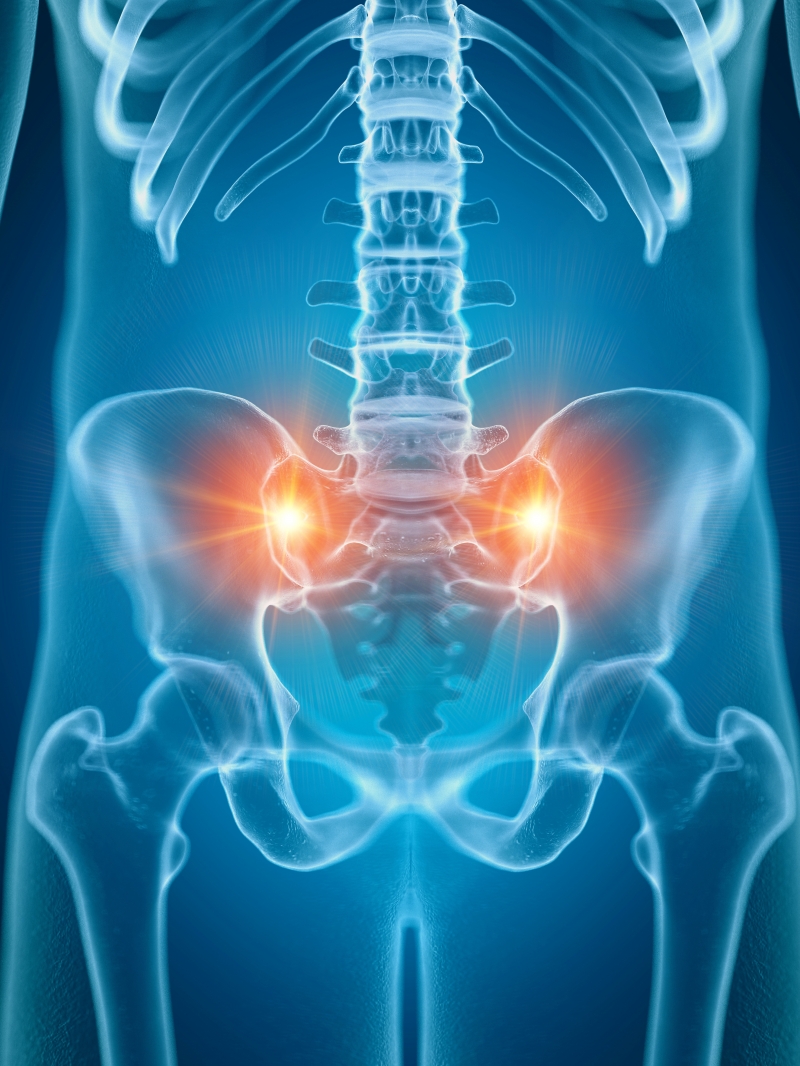
You may be a candidate for Minimally Invasive Sacroiliac Joint Fusion
Sacroiliac Joint Pain/Dysfunction
The sacroiliac joints are two cushioning, shock-absorbing structures located below the lumbar (lower back) region of the spine and above the coccyx (commonly referred to as the tailbone). Each joint is located on either side of a patient’s spine and helps carry the weight of the upper body. These small, strong joints connect the sacrum with the pelvis and are typically surrounded by several ligaments.
Commonly referred to as “S.I. joint pain,” sacroiliac joint dysfunction is considered to be a primary cause of lower back and leg discomfort. Sacroiliac joint dysfunction usually begins when one or both of the joints become inflamed or irritated for any number of reasons, and may continue to worsen. With professional medical treatment, however, many patients with sacroiliac joint dysfunction achieve full recovery.
Causes
Usually, sacroiliac joint dysfunction develops as the result of natural degenerative, age-related changes in the spine and joints. However, a variety of additional factors can also cause or intensify sacroiliac joint dysfunction and pain, including:
- Sudden injuries or traumas, such as might occur during a high-impact sport, car accident or fall
- Frequent, incorrect movements that affect the joints, including improper jogging, uneven strides, driving long distances or improperly lifting heavy objects
- Arthritis, especially osteoarthritis, which involves the deterioration of the cartilage that keeps bones in the sacroiliac joints from grinding against one another
- Pregnancy, due to hormones released that can cause joints to loosen
- Gout
- Bacterial infection
- Family history, genetics or congenital birth abnormalities, like one leg being longer or shorter than the other
- Obesity or extra weight
- Malnutrition
- Lack of exercise and extended periods of rest
- Previous spine-related complications or injuries
To prevent sacroiliac joint dysfunction, it is important to proactively address concerns and take necessary steps to ensure that your spine stays healthy throughout your lifetime. During a consultation at Laser Spine & Orthopedics®, one of our skilled spine specialists can assess your risk of contracting sacroiliac joint dysfunction and other painful issues. We can also provide preventative methods of care that are tailored to your unique lifestyle and goals, so that you have the tools you need for long-term spine wellness.
Symptoms
Because the sacroiliac joints have a specific location within the body, symptoms are typically highly localized. Some of the hallmark indicators of sacroiliac joint dysfunction include:
- Dull or sharp pain in the lower back and hips that sometimes extends to the groin and/or thighs
- Discomfort that worsens when standing or walking and improves when lying down
- Stiffness throughout the affected area
- A limited range of motion
- Burning sensations in the pelvic region
- Inflammation
If you are having trouble pinpointing the precise region of your body that is causing you to feel uncomfortable, our team of spine experts can conduct an advanced pain-mapping procedure to identify the exact origination of your pain. Generally, the more information that we can garner about your spine condition, then the more we can ensure the most optimal treatment for your needs.
Our Minimally Invasive Treatment Approach
Deficiencies in the sacroiliac joints may keep you from fully participating in everyday activities. However, there are many safe and effective treatments for S.I. joint pain, which oftentimes allow patients to make a full recovery from even the most severe cases of sacroiliac joint dysfunction. The experienced physicians and surgeons at Laser Spine & Orthopedics® regularly help patients find sustainable solutions to this condition and many others. By scheduling a consultation today, you can take control of your health and regain your quality of life.
During your initial visit, we will carefully review your medical history in detail and conduct a thorough examination of your symptoms and physical state. Because sacroiliac joint dysfunction can easily be mistaken for other conditions, Laser Spine & Orthopedics® may request a C.T. scan, MRI, X-ray or other imaging to rule out inaccurate diagnoses. An anesthetic injection block applied to the S.I. joint may also be considered, as this procedure is considered the gold standard as far as diagnostic tests for sacroiliac joint dysfunction. After obtaining a comprehensive diagnosis, our team can design a treatment plan to meet your individual needs and specifications.
Because of the immense amounts of research and evidence behind them, conservative treatments are typically recommended before surgery becomes an option. Some of the most beneficial non-surgical methods of care for sacroiliac joint dysfunction include:
- Pain-relieving and anti-inflammatory medications, which may be delivered topically, orally or through advanced methods such as localized injections, ultrasound technology or electrical stimulation therapy
- Physical therapy and guided exercises
- Heat and ice therapies, which optimize the body’s circulatory and healing processes
- Therapeutic massage
- Chiropractic manipulations
- Assistive devices like a sacroiliac belt (this tool, in particular, is commonly used for pregnant patients as their pain will likely resolve after giving birth)
- Psychological support
If non-invasive treatments do not appear to be giving our patients the relief they seek, then Dr. T will discuss minimally invasive SI joint stabilization/fusion. This state-of-the-art procedure removes cartilage from the sacroiliac joints and fuses the bones together, which often results in nearly immediate pain relief.
Following are just a few of the reasons why minimally invasive surgeries surpass traditional open surgeries in regards to patient advantages:
- Tiny incisions
- A reduced risk of blood loss or scarring
- Minimal trauma to surrounding muscles and tissue
- Quicker recovery times that allow patients to rapidly return to work, school and other responsibilities
- Faster pain relief
We look forward to helping you feel better, faster! CONTACT US
